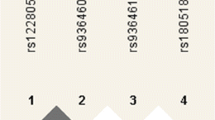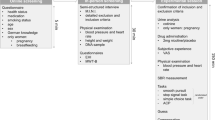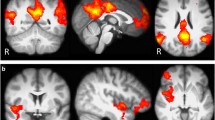Abstract
Rationale
A dopamine receptor 4 variable number tandem repeat (DRD4 VNTR) polymorphism has been related to reactivity to smoking cues among smokers, but the effect of this genetic variation on brain responses to smoking cues has not been evaluated.
Objectives
The present study evaluated the relationship between carrying the DRD4 VNTR 7-repeat allele and transient functional magnetic resonance imaging (fMRI) blood-oxygen-level-dependent responses to smoking cues among adult dependent cigarette smokers.
Materials and methods
Smokers (n = 15) underwent fMRI scanning after 2-h abstinence. During scanning, they viewed visual smoking and control cues. A blood sample was assayed for the DRD4 VNTR polymorphism, and participants were categorized based on whether they carried one or two copies of the 7-repeat allele (DRD4 L, n = 7) or not (DRD4 S, n = 8).
Results
Contrasts in brain cue-reactivity (smoking minus control cues) between DRD4 groups were conducted using SPM2. Smoking cues as compared to control cues elicited transient brain responses in right superior frontal gyrus (BA 8/9/10/32), left anterior cingulate gyrus (BA 32), and right cuneus (BA 19). Exposure to smoking cues resulted in greater activation of right superior frontal gyrus (BA 10) and right insula in DRD4 L compared to DRD4 S individuals. By contrast, exposure to smoking cues among DRD4 S individuals resulted in no significant increases in activation compared to DRD4 L individuals.
Conclusions
These brain imaging results suggest that DRD4 VNTR polymorphism is related to transient brain responses to smoking cues in regions subserving executive and somatosensory processes.

Similar content being viewed by others
References
Balfour DJ, Wright AE, Benwell ME, Birrell CE (2000) The putative role of extra-synaptic mesolimbic dopamine in the neurobiology of nicotine dependence. Behav Brain Res 113:73–83
Bassareo V, De Luca MA, Di Chiara G (2006) Differential impact of Pavlovian drug conditioned stimuli on in vivo dopamine transmission in the rat accumbens shell and core and in the prefrontal cortex. Psychopharmacology (Berl) 191:689–703
Bonson KR, Grant SJ, Contoreggi CS, Links JM, Metcalfe J, Weyl HL, Kurian V, Ernst M, London ED (2002) Neural systems and cue-induced cocaine craving. Neuropsychopharmacology 26:376–386
Brauer LH, Behm FM, Lane JD, Westman EC, Perkins C, Rose JE (2001a) Individual differences in smoking reward from de-nicotinized cigarettes. Nicotine Tob Res 3:101–109
Brauer LH, Cramblett MJ, Paxton DA, Rose JE (2001b) Haloperidol reduces smoking of both nicotine-containing and denicotinized cigarettes. Psychopharmacology (Berl) 159:31–7
Brody AL, Mandelkern MA, London ED, Childress AR, Lee GS, Bota RG, Ho ML, Saxena S, Baxter LR, Jr., Madsen D, Jarvik ME (2002) Brain metabolic changes during cigarette craving. Arch Gen Psychiatry 59:1162–72
Brody AL, Mandelkern MA, Olmstead RE, Scheibal D, Hahn E, Shiraga S, Zamora-Paja E, Farahi J, Saxena S, London ED, McCracken JT (2006) Gene variants of brain dopamine pathways and smoking-induced dopamine release in the ventral caudate/nucleus accumbens. Arch Gen Psychiatry 63:808–816
Cabeza R, Nyberg L (2000) Imaging cognition II: an empirical review of 275 PET and fMRI studies. J Cogn Neurosci 12:1–47
Carter BL, Tiffany ST (1999) Meta-analysis of cue-reactivity in addiction research. Addiction 94:327–340
Caskey NH, Jarvik ME, Wirshing WC, Madsen DC, Iwamoto-Schaap PN, Eisenberger NI, Huerta L, Terrace SM, Olmstead RE (2002) Modulating tobacco smoking rates by dopaminergic stimulation and blockade. Nicotine Tob Res 4:259-266
Congdon E, Lesch KP, Canli T (2007) Analysis of DRD4 and DAT polymorphisms and behavioral inhibition in healthy adults: implications for impulsivity. Am J Med Genet B Neuropsychiatr Genet (in press)
Cousins MS, Stamat HM, de Wit H (2001) Acute doses of d-amphetamine and bupropion increase cigarette smoking. Psychopharmacology (Berl) 157:243–253
Craig AD (2002) How do you feel? Interoception: the sense of the physiological condition of the body. Nat Rev Neurosci 3:655–666
Damasio AR, Grabowski TJ, Bechara A, Damasio H, Ponto LL, Parvizi J, Hichwa RD (2000) Subcortical and cortical brain activity during the feeling of self-generated emotions. Nat Neurosci 3:1049–1056
David SP, Munafo MR, Johansen-Berg H, Smith SM, Rogers RD, Matthews PM, Walton RT (2005) Ventral striatum/nucleus accumbens activation to smoking-related pictorial cues in smokers and nonsmokers: a functional magnetic resonance imaging study. Biol Psychiatry 58:488–494
Dawe S, Gullo MJ, Loxton NJ (2004) Reward drive and rash impulsiveness as dimensions of impulsivity: implications for substance misuse. Addict Behav 29:1389–1405
Di Chiara G (2000) Role of dopamine in the behavioural actions of nicotine related to addiction. Eur J Pharmacol 393:295–314
Due DL, Huettel SA, Hall WG, Rubin DC (2002) Activation in mesolimbic and visuospatial neural circuits elicited by smoking cues: evidence from functional magnetic resonance imaging. Am J Psychiatr 159:954–960
Ebstein RP (2006) The molecular genetic architecture of human personality: beyond self-report questionnaires. Mol Psychiatry 11:427–445
Fan J, Fossella J, Sommer T, Wu Y, Posner MI (2003) Mapping the genetic variation of executive attention onto brain activity. Proc Natl Acad Sci U S A 100:7406–7411
Faraone SV, Khan SA (2006) Candidate gene studies of attention-deficit/hyperactivity disorder. J Clin Psychiatry 67(Suppl 8):13–20
Friston KJ, Jezzard P, Turner R (1994) Analysis of functional MRI time-series. Hum Brain Mapp 1:153–171
Garavan H, Pankiewicz J, Bloom A, Cho JK, Sperry L, Ross TJ, Salmeron BJ, Risinger R, Kelley D, Stein EA (2000) Cue-induced cocaine craving: neuroanatomical specificity for drug users and drug stimuli. Am J Psychiatr 157:1789–1798
Gilbert DG, Rabinovich NE (1999) International Smoking Image Series, Version 1.2, 1.2 edn. Intergrative Neuroscience Laboratory, Southern Illinois University-Carbondale, Intergrative Neuroscience Laboratory, Southern Illinois University, Carbondale
Hamarman S, Fossella J, Ulger C, Brimacombe M, Dermody J (2004) Dopamine receptor 4 (DRD4) 7-repeat allele predicts methylphenidate dose response in children with attention deficit hyperactivity disorder: a pharmacogenetic study. J Child Adolesc Psychopharmacol 14:564–574
Huang S, Cook DG, Hinks LJ, Chen XH, Ye S, Gilg JA, Jarvis MJ, Whincup PH, Day IN (2005) CYP2A6, MAOA, DBH, DRD4, and 5HT2A genotypes, smoking behaviour and cotinine levels in 1518 UK adolescents. Pharmacogenet Genomics 15:839–850
Hutchison KE, LaChance H, Niaura R, Bryan A, Smolen A (2002a) The DRD4 VNTR polymorphism influences reactivity to smoking cues. J Abnorm Psychology 111:134–143
Hutchison KE, McGeary J, Smolen A, Bryan A, Swift RM (2002b) The DRD4 VNTR polymorphism moderates craving after alcohol consumption. Health Psychol 21:139–146
Lang PJ, Bradley MM, Cuthbert BN (1995) International affective picture system (IAPS): technical manual and affective ratings. NIMH Center for the Study of Emotion and Attention, University of FL, Gainesville, FL., NIMH Center for the Study of Emotion and Attention, University of FL, Gainesville, FL
Laucht M, Becker K, El-Faddagh M, Hohm E, Schmidt MH (2005) Association of the DRD4 exon III polymorphism with smoking in fifteen-year-olds: a mediating role for novelty seeking? J Am Acad Child Adolesc Psychiatry 44:477–484
Lee JH, Lim Y, Wiederhold BK, Graham SJ (2005) A functional magnetic resonance imaging (FMRI) study of cue-induced smoking craving in virtual environments. Appl Psychophysiol Biofeedback 30:195–204
Lichter JB, Barr CL, Kennedy JL, Van Tol HH, Kidd KK, Livak KJ (1993) A hypervariable segment in the human dopamine receptor D4 (DRD4) gene. Hum Mol Genet 2:767–773
Luciano M, Zhu G, Kirk KM, Whitfield JB, Butler R, Heath AC, Madden PA, Martin NG (2004) Effects of dopamine receptor D4 variation on alcohol and tobacco use and on novelty seeking: multivariate linkage and association analysis. Am J Med Genet B Neuropsychiatr Genet 124:113–23
Maldjian JA, Laurienti PJ, Kraft RA, Burdette JH (2003) An automated method for neuroanatomic and cytoarchitectonic atlas-based interrogation of fMRI data sets. NeuroImage 19:1233
Maldjian JA, Laurienti PJ, Burdette JH (2004) Precentral gyrus discrepancy in electronic versions of the Talairach atlas. NeuroImage 21:450
McBride D, Barrett SP, Kelly JT, Aw A, Dagher A (2006) Effects of expectancy and abstinence on the neural response to smoking cues in cigarette smokers: an fMRI study. Neuropsychopharmacology 31:2728–2738
McClernon FJ, Hiott FB, Huettel SA, Rose JE (2005) Abstinence-induced changes in self-report craving correlate with event-related FMRI responses to smoking cues. Neuropsychopharmacology 30:1940–1947
McClernon FJ, Fuemmeler BF, Kollins SH, Kail ME, Ashley-Koch AE (2007a) Interactions between genotype and retrospective ADHD symptoms predict lifetime smoking risk in a sample of young adults. Nicotine Tob Res (in press)
McClernon FJ, Hiott FB, Liu J, Salley A, Behm FM, Rose JE (2007b) Selectively reduced responses to smoking cues in amygdala following extinction-based smoking cessation: results of a preliminary fMRI study. Addiction Biology (in press)
Munafo MR (2006) Candidate gene studies in the 21st century: meta-analysis, mediation, moderation. Genes Brain Behav 5(Suppl 1):3–8
Naqvi NH, Rudrauf D, Damasio H, Bechara A (2007) Damage to the insula disrupts addiction to cigarette smoking. Science 315:531–534
Niaura R, Shadel WG, Abrams DB, Monti PM, Rohsenow DJ, Sirota A (1998) Individual differences in cue reactivity among smokers trying to quit: effects of gender and cue type. Addict Behav 23:209–224
Noain D, Avale ME, Wedemeyer C, Calvo D, Peper M, Rubinstein M (2006) Identification of brain neurons expressing the dopamine D4 receptor gene using BAC transgenic mice. Eur J Neurosci 24:2429–2438
Payne BK, McClernon FJ, Dobbins IG (2007) Automatic affective responses to smoking cues. Exp Clin Psychopharmacol (in press)
Perkins KA, Gerlach D, Vender J, Grobe J, Meeker J, Hutchison S (2001) Sex differences in the subjective and reinforcing effects of visual and olfactory cigarette smoke stimuli. Nicotine Tob Res 3:141–150
Rose JE (2006) Nicotine and nonnicotine factors in cigarette addiction. Psychopharmacology (Berl) 184:274–285
Rose JE, Levin ED, Behm FM, Adivi C, Schur C (1990) Transdermal nicotine facilitates smoking cessation. Clin Pharmacol Ther 47:323–330
Rush CR, Higgins ST, Vansickel AR, Stoops WW, Lile JA, Glaser PE (2005) Methylphenidate increases cigarette smoking. Psychopharmacology (Berl) 181:781–789
Sander T, Harms H, Dufeu P, Kuhn S, Rommelspacher H, Schmidt LG (1997) Dopamine D4 receptor exon III alleles and variation of novelty seeking in alcoholics. Am J Med Genet 74:483–487
Seeger G, Schloss P, Schmidt MH (2001) Marker gene polymorphisms in hyperkinetic disorder-predictors of clinical response to treatment with methylphenidate? Neurosci Lett 313:45–48
Shao C, Li Y, Jiang K, Zhang D, Xu Y, Lin L, Wang Q, Zhao M, Jin L (2006) Dopamine D4 receptor polymorphism modulates cue-elicited heroin craving in Chinese. Psychopharmacology (Berl) 186:185–190
Shiffman SM, Jarvik ME (1976) Smoking withdrawal symptoms in two weeks of abstinence. Psychopharmacology (Berl) 50:35–39
Shiffman S, Gwaltney CJ, Balabanis MH, Liu KS, Paty JA, Kassel JD, Hickcox M, Gnys M (2002) Immediate antecedents of cigarette smoking: an analysis from ecological momentary assessment. J Abnorm Psychol 111:531–545
Smolka MN, Buhler M, Klein S, Zimmermann U, Mann K, Heinz A, Braus DF (2005) Severity of nicotine dependence modulates cue-induced brain activity in regions involved in motor preparation and imagery. Psychopharmacology (Berl) 184:577–588
Sobik L, Hutchison K, Craighead L (2005) Cue-elicited craving for food: a fresh approach to the study of binge eating. Appetite 44:253–261
Tzourio-Mazoyer N, Landeau B, Papathanassiou D, Crivello F, Etard O, Delcroix N, Mazoyer B, Joliot M (2002) Automated anatomical labeling of activations in SPM using a macroscopic anatomical parcellation of the MNI MRI single-subject brain. NeuroImage 15:273
Volkow ND, Fowler JS, Wang GJ, Swanson JM (2004) Dopamine in drug abuse and addiction: results from imaging studies and treatment implications. Mol Psychiatry 9:557–569
Waters AJ, Shiffman S, Sayette MA, Paty JA, Gwaltney CJ, Balabanis MH (2003) Attentional bias predicts outcome in smoking cessation. Health Psychol 22:378–387
Wilson SJ, Sayette MA, Delgado MR, Fiez JA (2005) Instructed smoking expectancy modulates cue-elicited neural activity: a preliminary study. Nicotine Tob Res 7:637–645
Acknowledgements
The authors wish to thank Mr. Berry Hiott for collection of fMRI data and Dr. Scott Kollins for his comments on an earlier version of this manuscript. This research supported by NIDA K23DA017261 (FJM), NIAAA R01AA012238-07 (KEH), and an unrestricted donation from Vector Tobacco Co. (JER).
Author information
Authors and Affiliations
Corresponding author
Rights and permissions
About this article
Cite this article
McClernon, F.J., Hutchison, K.E., Rose, J.E. et al. DRD4 VNTR polymorphism is associated with transient fMRI-BOLD responses to smoking cues. Psychopharmacology 194, 433–441 (2007). https://doi.org/10.1007/s00213-007-0860-6
Received:
Accepted:
Published:
Issue Date:
DOI: https://doi.org/10.1007/s00213-007-0860-6




